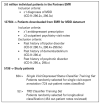Using electronic medical records to enable large-scale studies in psychiatry: treatment resistant depression as a model
- PMID: 21682950
- PMCID: PMC3837420
- DOI: 10.1017/S0033291711000997
Using electronic medical records to enable large-scale studies in psychiatry: treatment resistant depression as a model
Abstract
Background: Electronic medical records (EMR) provide a unique opportunity for efficient, large-scale clinical investigation in psychiatry. However, such studies will require development of tools to define treatment outcome.
Method: Natural language processing (NLP) was applied to classify notes from 127 504 patients with a billing diagnosis of major depressive disorder, drawn from out-patient psychiatry practices affiliated with multiple, large New England hospitals. Classifications were compared with results using billing data (ICD-9 codes) alone and to a clinical gold standard based on chart review by a panel of senior clinicians. These cross-sectional classifications were then used to define longitudinal treatment outcomes, which were compared with a clinician-rated gold standard.
Results: Models incorporating NLP were superior to those relying on billing data alone for classifying current mood state (area under receiver operating characteristic curve of 0.85-0.88 v. 0.54-0.55). When these cross-sectional visits were integrated to define longitudinal outcomes and incorporate treatment data, 15% of the cohort remitted with a single antidepressant treatment, while 13% were identified as failing to remit despite at least two antidepressant trials. Non-remitting patients were more likely to be non-Caucasian (p<0.001).
Conclusions: The application of bioinformatics tools such as NLP should enable accurate and efficient determination of longitudinal outcomes, enabling existing EMR data to be applied to clinical research, including biomarker investigations. Continued development will be required to better address moderators of outcome such as adherence and co-morbidity.
Figures


Similar articles
-
Incorporating natural language processing to improve classification of axial spondyloarthritis using electronic health records.Rheumatology (Oxford). 2020 May 1;59(5):1059-1065. doi: 10.1093/rheumatology/kez375. Rheumatology (Oxford). 2020. PMID: 31535693 Free PMC article.
-
Automated feature selection of predictors in electronic medical records data.Biometrics. 2019 Mar;75(1):268-277. doi: 10.1111/biom.12987. Epub 2019 Apr 2. Biometrics. 2019. PMID: 30353541
-
Identification of Patients With Metastatic Prostate Cancer With Natural Language Processing and Machine Learning.JCO Clin Cancer Inform. 2022 Oct;6:e2100071. doi: 10.1200/CCI.21.00071. JCO Clin Cancer Inform. 2022. PMID: 36215673
-
Natural language processing of symptoms documented in free-text narratives of electronic health records: a systematic review.J Am Med Inform Assoc. 2019 Apr 1;26(4):364-379. doi: 10.1093/jamia/ocy173. J Am Med Inform Assoc. 2019. PMID: 30726935 Free PMC article.
-
Optimising the use of electronic medical records for large scale research in psychiatry.Transl Psychiatry. 2024 Jun 1;14(1):232. doi: 10.1038/s41398-024-02911-1. Transl Psychiatry. 2024. PMID: 38824136 Free PMC article. Review.
Cited by
-
Penetrance and Pleiotropy of Polygenic Risk Scores for Schizophrenia in 106,160 Patients Across Four Health Care Systems.Am J Psychiatry. 2019 Oct 1;176(10):846-855. doi: 10.1176/appi.ajp.2019.18091085. Epub 2019 Aug 16. Am J Psychiatry. 2019. PMID: 31416338 Free PMC article.
-
Comparing deep learning and concept extraction based methods for patient phenotyping from clinical narratives.PLoS One. 2018 Feb 15;13(2):e0192360. doi: 10.1371/journal.pone.0192360. eCollection 2018. PLoS One. 2018. PMID: 29447188 Free PMC article.
-
Predicting mental conditions based on "history of present illness" in psychiatric notes with deep neural networks.J Biomed Inform. 2017 Nov;75S:S138-S148. doi: 10.1016/j.jbi.2017.06.010. Epub 2017 Jun 10. J Biomed Inform. 2017. PMID: 28606869 Free PMC article.
-
Hospital Readmission and Social Risk Factors Identified from Physician Notes.Health Serv Res. 2018 Apr;53(2):1110-1136. doi: 10.1111/1475-6773.12670. Epub 2017 Mar 13. Health Serv Res. 2018. PMID: 28295260 Free PMC article.
-
Prevalence of Mental Illnesses in Domestic Violence Police Records: Text Mining Study.J Med Internet Res. 2020 Dec 24;22(12):e23725. doi: 10.2196/23725. J Med Internet Res. 2020. PMID: 33361056 Free PMC article.
References
-
- Charlson M, Szatrowski TP, Peterson J, Gold J. Validation of a combined comorbidity index. Journal of Clinical Epidemiology. 1994;47:1245–1251. - PubMed
-
- Charlson ME, Pompei P, Ales KL, MacKenzie CR. A new method of classifying prognostic comorbidity in longitudinal studies: development and validation. Journal of Chronic Diseases. 1987;40:373–383. - PubMed
-
- Effler P, Ching-Lee M, Bogard A, Ieong MC, Nekomoto T, Jernigan D. Statewide system of electronic notifiable disease reporting from clinical laboratories: comparing automated reporting with conventional methods. Journal of the American Medical Association. 1999;282:1845–1850. - PubMed
Publication types
MeSH terms
Grants and funding
LinkOut - more resources
Full Text Sources

